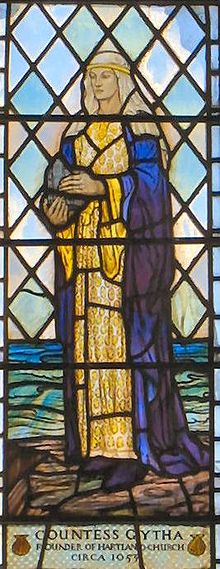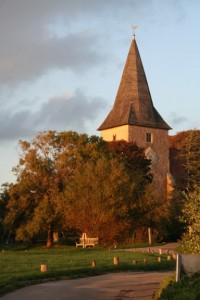
Overshadowed by their husbands or subject to their fathers’ ambitions, noble medieval women had to be pretty plucky to carve out a niche in the history books. Still, Gytha Thorkelsdóttir was related to so many famous (and mostly tragic) figures that it is amazing we know so little about her.
Raised in Denmark, she was the sister of Earl Ulf who served Canute as Regent of Denmark before his unfortunate death (reportedly killed by Canute’s order). Her father Thorkel (also known as Torkel, Torgils, or Thorgil) was said to have been the grandson of a bear and a Swedish maiden. Of course, having a bear as an ancestor is only mentioned when referring to a male (like Ulf), but I can only assume that a female of the line would absorb the same characteristics?
Ulf was married to Canute’s sister, which made Gytha part of the royal family. So it may have been a great surprise to Gytha when King Canute married her off to his favorite, Godwine. Probably from a less than stellar background (his father was an out-of-favor Thegn in England), Godwine’s rapid rise to power was destined to make him the most important man in England after the king. But he hadn’t achieved this status yet, though he may have been Earl of Wessex when they married. I doubt whether Gytha was given a choice.
They did have a large family: at least 10, possibly 11 children. Among their brood was Harold Godwineson (last Saxon King of England), Edith Queen of England (married to Edward the Confessor), and three earls. However, it was her misfortune to outlive at least six of them; she lost three in one day at the Battle of Hastings, for Harold died alongside his brothers Gyrth and Leofwine. And of course this was only two weeks after the death of Tostig at the Battle of Stamfordbridge. How a mother felt seeing two sons face each other as enemies across the battlefield can only be surmised. There was never any indication that she had a falling out with Tostig; in fact, it is rumored that he visited her on the way out of the country when forced into exile.
 It was written that Gytha petitioned William the Conqueror to let her take Harold’s body after Hastings and even offered to pay him its weight in gold. But William refused, fearing the Saxons would turn Harold’s burial site into a shrine. However, local legend at Bosham declares that the unidentified bones beneath the floor of Holy Trinity Church belong to Harold who was secretly buried there after the fact. The estates around Bosham were confiscated by William the Conqueror, and if he did take pity and let Gytha bring the body there, it would have been possible to keep the event a secret. Regardless, she had to leave her home in Bosham and it was probable that Gytha went to live in Exeter.
It was written that Gytha petitioned William the Conqueror to let her take Harold’s body after Hastings and even offered to pay him its weight in gold. But William refused, fearing the Saxons would turn Harold’s burial site into a shrine. However, local legend at Bosham declares that the unidentified bones beneath the floor of Holy Trinity Church belong to Harold who was secretly buried there after the fact. The estates around Bosham were confiscated by William the Conqueror, and if he did take pity and let Gytha bring the body there, it would have been possible to keep the event a secret. Regardless, she had to leave her home in Bosham and it was probable that Gytha went to live in Exeter.
Exeter became a focal point of local rebellion, led by her Gytha and her three grandsons Godwine, Edmund, and Magnus (Harold’s sons); King William took the threat seriously enough to lay siege to the city for 18 days in the winter of 1068. As usual, William overcame their resistance and Exeter capitulated, while Gytha, accompanied by her allies, fled to the island of Flat Holm in the Bristol channel. There she stayed for many months while waiting for her grandsons to return, aided by King Diarmaid of Leinster. Unfortunately, their last invasion was a disaster and, conceding defeat, they all left England for good and traveled to Flanders. She may have entered a convent at St. Omer. Or she might have gone back to Scandinavia, where the presiding King of Denmark was her nephew. It is thought that Gytha died four years later.
Geoffrey Tobin says:
I know there’s still contention about whether the remains at Boshom are Harold’s or not, but the evident injuries do match what was shamefully done to the finally helpless Harold by a band of Normans and Flemings according to the “Carmen de Hastingae Proelio” written by Bishop Guy of Amiens who was the uncle of one of the (implicated) witnesses, Hugh of Ponthieu, younger brother of Count Guy of Ponthieu who had captured the shipwrecked Harold in 1064.
William the Conqueror, it’s said, was aghast at the mutilation of Harold’s body, so it’s surmised that the praise of William in the “Carmen” was an attempt by the Bishop to regain favour for his disgraced family.